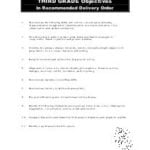CURRICULUM MENU




About this Curriculum Guide for Third Grade Students
Each of these lessons has been tested in the classroom and taught successfully for many years. These lessons are intended as an extension to the foundational Introductory Lessons which have the background and methodology needed to implement drama and a foundation to kick off your drama work. Like any academic area, Drama has a scope and sequence of learning (knowledge and skills). This body of lessons is developed to cover essential learning in the art form for eight- to nine-year-old students.
The objectives in this Drama Curriculum can essentially be sorted into three categories:
- Self-management (intrapersonal) objectives
- Collaborative (interpersonal) objectives
- Discipline based-art objectives
These three categories are interdependent, but much is gained from teaching them specifically and in a sequence that builds understanding and competence.
National Core Arts Standards
The curriculum objectives are aligned with the United States National Standards, and a chart is included in the objectives so that you can see that alignment. Many states and nations have other standards. You are encouraged to look at your state’s or nation’s drama standards and see what lessons you might omit or determine some you might need to create so that all standards are covered adequately.
Curriculum Lesson Sequence
The lessons referenced in the sequence are put in a recommended delivery order, but you may revise, rearrange, and adapt as you see fit. Tying it all together is a year-long planning guide ["Third Grade Lessons"] to map a school year of drama teaching based on the lessons in this guide. This sequence is not a mandate; rather, it is intended to provide you with assistance as you select the lessons for your classroom. NOTE: this sequence is for classes with PRIOR drama instruction.
These specific grade level lessons are all you will need to cover the drama knowledge and skills, and connect drama to your classroom teaching. For classes without prior experience, begin with our foundational Introductory Lessons. If teachers, in grades that precede yours, are already teaching drama, you don’t need to teach those foundational lessons, just begin with this new set of lessons.
Exploratory or Essential Question
The main lesson is written with as much detail as possible for ease of implementation. Each lesson has a sample exploratory or essential question that drives the instruction. What is the difference? An exploratory question is something that has a definitive answer and will not take years of study to understand it or uncover all of the meanings. An essential question is connected to more enduring understandings and will, perhaps, take years to uncover and understand entirely. Essential questions are tied to even bigger ideas.
Student-Centered Approach
In my work and in these lessons, I am always moving students through a gradual release process, from me modeling or guiding the drama to them independently creating stories. I have tried to make this distinction in the lesson steps. When the teacher is in the lead, the lesson step begins with a verb (e.g., model, explain, lead, have students). When students are in the lead or working independently, the lesson step describes their work (e.g., students brainstorm, groups plan and practice).
